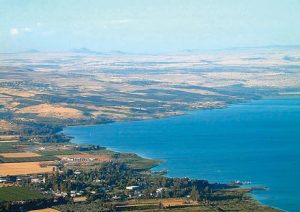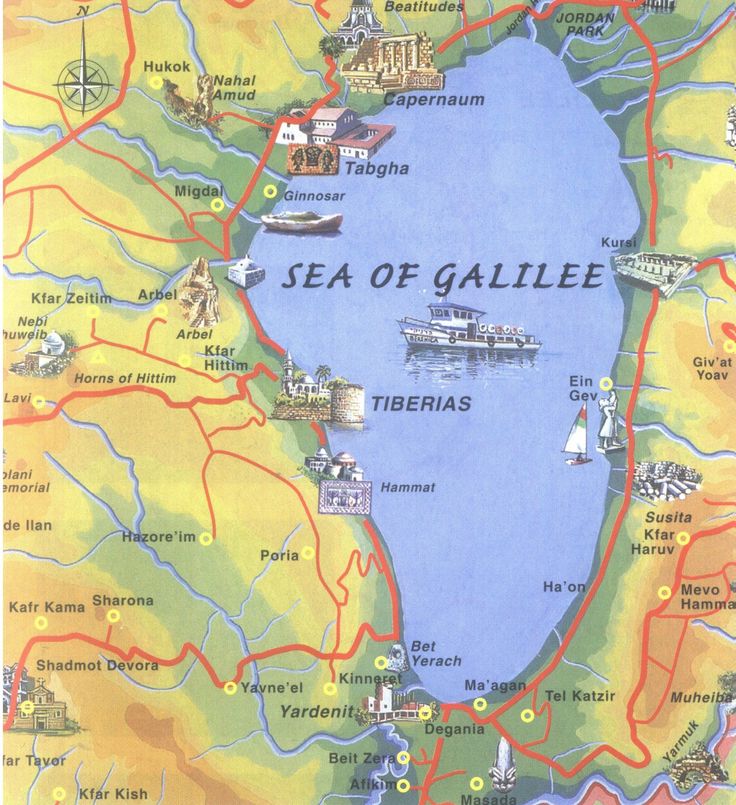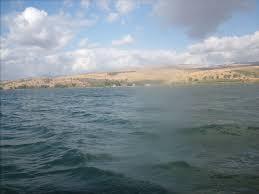6 After this Jesus went to the other side of the Sea of Galilee, also called the Sea of Tiberias.[a] 2 A large crowd kept following him, because they saw the signs that he was doing for the sick. 3 Jesus went up the mountain and sat down there with his disciples. 4 Now the Passover, the festival of the Jews, was near. 5 When he looked up and saw a large crowd coming toward him, Jesus said to Philip, “Where are we to buy bread for these people to eat?” 6 He said this to test him, for he himself knew what he was going to do. [John 6:1-6, NRSV]
Quoting the prophecy in Isaiah 9:1, the Gospel of Matthew says that after the arrest of John the Baptist, Jesus left Nazareth and went to dwell in Capernaum by the sea, in the territory of Zebulun and Naphtali.
- “Land of Zebulun, land of Naphtali, on the road by the sea, across the Jordan, Galilee of the Gentiles – the people who sat in darkness have seen a great light, and for those who sat in the region and shadow of death light has dawned.” (Matthew 4:15-16).
According to the Gospels, most of Jesus’ three-year public ministry centered around the Sea of Galilee. It was an itinerant ministry along the shore of this lowest fresh water lake on earth. Here, most of his parables were delivered and miracles performed. Early Christians hallowed the lakeside, building churches commemorating the feeding of the five thousand, the Sermon on the Mount, the primacy of Peter, and the house of Peter.
The largest freshwater lake in Israel, the Sea of Galilee lies 680 feet below sea level, runs about 13 miles long and 8 miles wide, but only 150 feet deep. Apart from supplying as a primary source of drinking water for Israel, it serves as a popular area for recreation and tourism. It is fed partly by underground springs but mainly by the Jordan River, drains to the south and flows into the Dead Sea.
The Sea of Galilee went by different names in the New Testament, including the Lake of Gennesaret (Luke 5:1) and the Sea of Tiberias (John 6:1). Its modern Hebrew name, Kinneret, comes from the Hebrew Bible, where it appears as the “sea of Kinneret” in Numbers 34:11 and Joshua 13:27.
The differences in climate and elevation between the sea and the eastern mountains cause strong winds. So other than fishing and trade, the Sea of Galilee was also known for sudden, violent storms. Tilapia zilli, a red-belly tilapia nicknamed “St. Peter’s fish”, is served in Tiberias restaurants.
Jesus crossed the Sea of Galilee many times, walked on it (Matthew 14:22–33) and calmed its storm (Mark 4:35-41).
Reflection:
During the pilgrimage, we took a boat-ride on the Lake of Galilee. It helps us to reflect on three points.
1. Receiving and Passing On
Lake Galilee receives water from the River Jordan and delivers water to the Dead Sea.
- Fresh water flows in and fresh water flows out.
- The lake takes and the lake gives.
- It is a living fresh water lake.
- Ecology around the lake thrives and fishes breed and live in it.
But the Dead Sea only receives and it does not give.
- It is extremely saline.
- It is a dead lake.
- Nothing lives in it or grows around it.
- The ecology is just plain dead.
2. Of Givers and Takers
This is reflective of charity in Christian life.
In most families, in faith communities and in the larger society, we come across “givers” and “takers”, those who are heartily generous towards others and those who heartlessly live off others’ generosity, never mindful of making return-gifts.
In between givers and takers, so we are reminded, lurks a group described as “intermediaries”. These are of two types. One type consists of givers who take the trouble, making arrangements and expending time and energy, and even incurring expenses helping to connect givers (benefactors) with worthy recipients (beneficiaries who are truly in need). One ready example is Oprah Winfrey who created a worthy charitable cause during the devastating aftermath of Hurricane Kathrina in New Orleans. She used her influence to offer the possibility for the able and willing givers to donate millions towards building new houses for those who lost their homes. Making repeated donations to this cause, Bon Jovi asked not to be thanked but, instead, thanked Oprah for making it possible for people like him to donate.
The second type, however, is different and it consists of those who plot and connive with heartless takers to take advantage of the generosity of the givers. Once their plots have become evident, there is no good reason for the generous givers to attend to such evil intermediaries and takers.
3. Giving, Charity and Hospital
The term “charity” assumes several meanings.
Charity is giving. With generosity and helpfulness, aid is given to those in need or suffering.
Charitable institutions engage in public provision of different kinds for the relief of the needy and the poor. This is benevolent goodwill towards or love of humanity, manifesting a fundamental Christian attitude of solidarity and co-humanity.
Charity also finds its way to lenient judgment of others.
It may also simply mean a gift for public benevolent purposes. A lasting example founded by such a gift may sometimes be seen in an institution such as a hospital.
The term “hospital” is linked to the concept of philanthropy. In the Middle Ages, it meant “shelter for the needy”, “hostel, shelter, lodging”, “guest-house, inn”. From the word hospes in Latin, signifying a stranger or foreigner, hence a guest, hospital carries with it “the duties of hospitality to a guest”. Hospitality is signified by hospitium, another noun derived from this, and speaks of the relation between guest and shelterer, hospitality, friendliness, and hospitable reception.
Today, we take inspiration from Pope Francis who leads by example and compels the Catholic Church to reorient itself as a “field hospital” that cleans and heals wounds. He is challenging all of us to rethink ecclesial life so as to give priority to the wounded. The Pope says:
- “So many people need their wounds healed! This is the mission of the Church: to heal the wounds of the heart, to open doors, to free people, to say that God is good, God forgives all. God is the Father. God is affectionate. God always waits for us.”
This means placing the needs of others before our own. The Church must now stop being “self-referential”, and bravely allow Christ to “come out”. When the Church keeps Christ to itself and does not let him out, it becomes self-referential, and then gets sick. To avoid this, the Church must go out of itself to the peripheries, to minister to the needy. It must act and work like a “field hospital”, taking in and caring for the wounded and weary along the journey of life, and offer them rest and peace. The Pope invites us to enter into fresh imagination, and rethink our identity, our mission and our life together as disciples of Christ. We must all learn to be givers, rather than mere takers. Genuine givers are alive in wholesome spiritual health.
Copyright © Dr. Jeffrey & Angie Goh, January 2019. All rights reserved.
You are most welcome to respond to this post. Email your comments to jeffangiegoh@gmail.com. You can also be dialogue partners in this Ephphatha Coffee-Corner Ministry by sending us questions for discussion.



